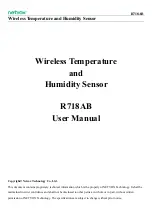
11
7. Information about Battery Passivation
Many of Netvox devices are powered by 3.6V ER14505 Li-SOCl2 (lithium-thionyl chloride) batteries that offer many advantages
including low self-discharge rate and high energy density.
However, primary lithium batteries like Li-SOCl2 batteries will form a passivation layer as a reaction between the lithium anode
and thionyl chloride if they are in storage for a long time or if the storage temperature is too high. This lithium chloride layer prevents
rapid self-discharge caused by continuous reaction between lithium and thionyl chloride, but battery passivation may also lead to
voltage delay when the batteries are put into operation, and our devices may not work correctly in this situation.
As a result, please make sure to source batteries from reliable vendors, and it is suggested that if the storage period is more than
one month from the date of battery production, all the batteries should be activated.
If encountering the situation of battery passivation, users can activate the battery to eliminate the battery hysteresis.
ER14505 Battery Passivation:
7.1 To determine whether a battery requires activation
Connect a new ER14505 battery to a resistor in parallel, and check the voltage of the circuit.
If the voltage is below 3.3V, it means the battery requires activation.
7.2 How to activate the battery
a. Connect a battery to a resistor in parallel
b. Keep the connection for 5~8 minutes
c. The voltage of the circuit should be
≧
3.3, indicating successful activation.
Brand
Load Resistance
Activation Time
Activation Current
NHTONE
165 Ω
5 minutes
20mA
RAMWAY
67 Ω
8 minutes
50mA
EVE
67 Ω
8 minutes
50mA
SAFT
67 Ω
8 minutes
50mA
Note:
If you buy batteries from other than the above four manufacturers, then the battery activation time, activation current, and required
load resistance shall be mainly subject to the announcement of each manufacturer.































